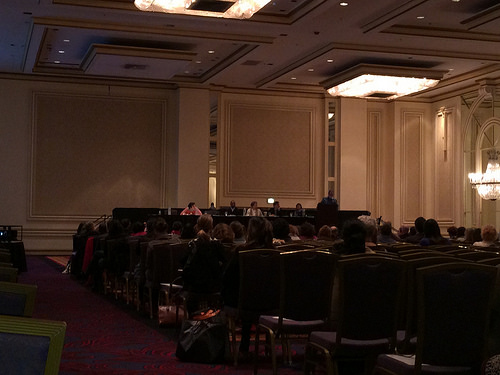
CAA and moving forward…
[flickr id=”12624457023″ thumbnail=”medium” overlay=”true” size=”original” group=”” align=”none”] The CAA (College Art Association) conference was this last weekend. It was a little overwhelming. I helped man the table for the Graduate Admissions office on Friday. I split my time sitting at the table and wandering around. I brought my comic book convention mentality of aimlessly wandering and accidentally finding the perfect panel. At the last comic book convention I attended, I stumbled into seeing John Barrowman, an actor that I endlessly admire. At CAA my approach led me to a panel on Social Practice in Chicago.
It was perfect.
Most notably, I saw Michael Rakowitz and Theaster Gates give very moving presentations. Michael Rakowitz hooked me by starting his presentation with sharing his love of live recording albums. He used them as an analogy of the documentation that remains after a social practice art event takes place. The benefit of the live album is that it can preserve the act of the event, whereas photographic documentation runs the risk of stagnating and becoming institutionalized. One of the key points of Social Practice as an art form is in its institutional critique of the museum and gallery system. He then went on to talk about one of his most recent works where he recreated the famous Beatles rooftop farewell concert with a Beatles cover band in Jerusalem. This is a poor description of the work, there was a lot more baggage to it. The work was recently on display here in Chicago at he Rhona Hoffman Gallery.
After that, Theaster Gates took the podium. Immediately you as an audience member saw the down-to-earth-ness of Gates. He was star-struck by Rakowitz, who had apparently been cited in his own thesis paper years earlier. He then went right into an incredible talk. I’m not ashamed to say that I was moved to tears during his time on stage. He started by speaking about his youth as a religious young man who had looked to the church to solve many of the world’s problems. When the church had failed him, he moved on to making art. He then looked to the galley system to solve the problems he saw facing the art world. When that system failed him, he took things into his own hands. Gates then sought to bring the art world to the people it was neglecting. In his case he brought it to the South Side of Chicago. He turned a project into a loving archive of its community.
Hearing these speakers brought out all sorts of hopes and goals in me. It’s amazing when you hear just the right set of words that inspire you to start thinking about the next level of your work. My project is already moving toward a social practice and I am now staring into the future and can see a path I would like to take it on. I am so thankful and lucky that I stumbled into that conference room. Now I’m ready to move forward.
